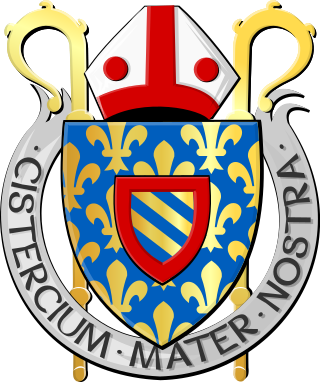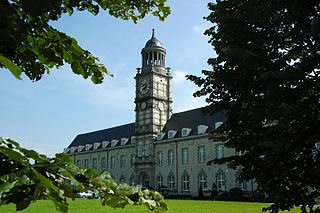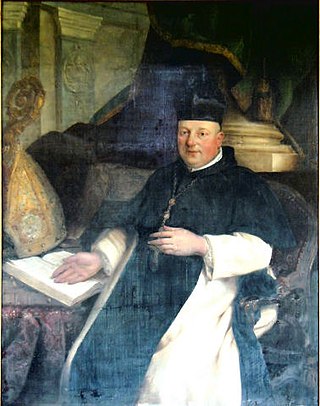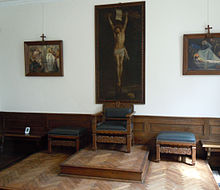
The Cistercians, officially the Order of Cistercians, are a Catholic religious order of monks and nuns that branched off from the Benedictines and follow the Rule of Saint Benedict, as well as the contributions of the highly-influential Bernard of Clairvaux, known as the Latin Rule. They are also known as Bernardines, after Saint Bernard himself, or as White Monks, in reference to the colour of the "cuculla" or cowl worn by the Cistercians over their habits, as opposed to the black cowl worn by Benedictines.

Fountains Abbey is one of the largest and best preserved ruined Cistercian monasteries in England. It is located approximately 3 miles (5 km) south-west of Ripon in North Yorkshire, near to the village of Aldfield. Founded in 1132, the abbey operated for 407 years, becoming one of the wealthiest monasteries in England until its dissolution, by order of Henry VIII, in 1539.

Buckfast Abbey forms part of an active Benedictine monastery at Buckfast, near Buckfastleigh, Devon, England. Buckfast first became home to an abbey in 1018. The first Benedictine abbey was followed by a Savignac abbey constructed on the site of the current abbey in 1134. The monastery was surrendered for dissolution in 1539, with the monastic buildings stripped and left as ruins, before being finally demolished. The former abbey site was used as a quarry, and later became home to a Gothic mansion house.

The Trappists, officially known as the Order of Cistercians of the Strict Observance and originally named the Order of Reformed Cistercians of Our Lady of La Trappe, are a Catholic religious order of cloistered monastics that branched off from the Cistercians. They follow the Rule of Saint Benedict and have communities of both monks and nuns that are known as Trappists and Trappistines, respectively. They are named after La Trappe Abbey, the monastery from which the movement and religious order originated. The movement first began with the reforms that Abbot Armand Jean le Bouthillier de Rancé introduced in 1664, later leading to the creation of Trappist congregations, and eventually the formal constitution as a separate religious order in 1892.

Heiligenkreuz Abbey is a Cistercian monastery in the village of Heiligenkreuz in the southern part of the Vienna woods, c. 13 km north-west of Baden in Lower Austria. It is the oldest continuously occupied Cistercian monastery in the world.

Orval Abbey is a Cistercian monastery founded in 1132 in the Gaume region of Belgium and is located in Villers-devant-Orval, part of Florenville, Wallonia in the province of Luxembourg. The abbey is well known for its history and spiritual life but also for its local production of the Trappist beer Orval and a specific cheese.

Lérins Abbey is a Cistercian monastery on the island of Saint-Honorat, one of the Lérins Islands, on the French Riviera, with an active monastic community.

Mount St Bernard Abbey is a Roman Catholic, Trappist monastery near Coalville, Leicestershire, England, founded in 1835 in the parish of Whitwick and now in that of Charley. The abbey was the first permanent monastery to be founded in England since the Reformation and is the sole Trappist house in England. The monks brew the only Trappist beer in Britain.

Val-Dieu Abbey is a former Cistercian monastery in Wallonia in the Berwinne valley near Aubel in the Pays de Herve.

Casamari Abbey is a Cistercian abbey in the Province of Frosinone, Lazio, Italy, about 10 kilometers east-south-east of Veroli.
Westmalle Abbey, otherwise the Trappist Abbey of Westmalle, is a monastery of the Cistercians of Strict Observance in Westmalle in the Belgian province of Antwerp.

Alice of Schaerbeek, was a Cistercian laysister who is venerated as the patron saint of the blind and paralyzed. Her feast day is 15 June.
Garendon Abbey was a Cistercian abbey located between Shepshed and Loughborough, in Leicestershire, United Kingdom.

St. Sixtus' Abbey, Westvleteren, which belongs to the Cistercians of Strict Observance, or Trappists, is a Roman Catholic abbey located in Westvleteren, in the Belgian Province of West Flanders. The abbey is famous for its spiritual life, characterised by prayer, reading, and manual work, the three basic elements of Trappist life. It has also a reputation for its brewery, one of several producers of Trappist beer in Belgium.

St. Bernard's Abbey, Hemiksem, or abbatiae S. Bernardi ad Scaldim, ordinis Cisterciensis, in dioecesi Antverpiensi also known as St. Bernard's Abbey on the Scheldt, located in Hemiksem in the province of Antwerp in Belgium, was a Cistercian monastery founded in 1243 and dissolved during the French Revolution. The buildings are now the property of the municipality of Hemiksem.

Igny Abbey or Val d'Igny Abbey is a Cistercian abbey located in Arcis-le-Ponsart, Marne, France. It was founded in 1128 for Cistercian monks, dissolved in 1791 during the French Revolution, re-established in 1876 for Trappist monks, destroyed in 1918, reopened in 1929 for Trappist nuns and modernised in 2008–12 to accommodate three or four pre-existing communities.

St. Benedictusberg Abbey, also Mamelis Abbey, is a Benedictine monastery established in 1922 in Mamelis, a hamlet which administratively falls within Vaals, Netherlands. It is a rijksmonument.

Gerardus Franciscus Amadeus de Bie was a Belgian abbot of Bornem Abbey. He became the 74th Abbot-General of the Cistercian Order.

Dom Benedictus Neefs, O.Cist. was the 46th abbot of Hemiksem Abbey.





















